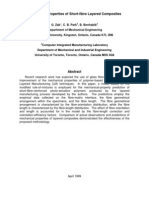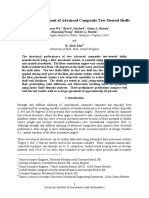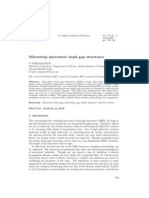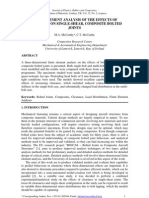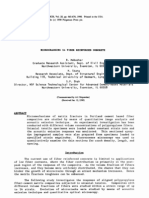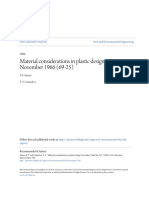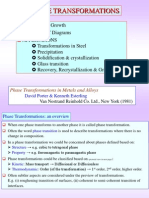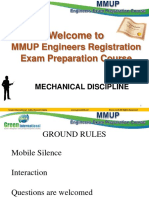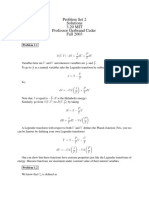ABD Matrix of Single-Ply Triaxial Weave Fabric Composites: A.B.H. Kueh and S. Pellegrino
ABD Matrix of Single-Ply Triaxial Weave Fabric Composites: A.B.H. Kueh and S. Pellegrino
Uploaded by
Vishnu Chemmanadu AravindCopyright:
Available Formats
ABD Matrix of Single-Ply Triaxial Weave Fabric Composites: A.B.H. Kueh and S. Pellegrino
ABD Matrix of Single-Ply Triaxial Weave Fabric Composites: A.B.H. Kueh and S. Pellegrino
Uploaded by
Vishnu Chemmanadu AravindOriginal Title
Copyright
Available Formats
Share this document
Did you find this document useful?
Is this content inappropriate?
Copyright:
Available Formats
ABD Matrix of Single-Ply Triaxial Weave Fabric Composites: A.B.H. Kueh and S. Pellegrino
ABD Matrix of Single-Ply Triaxial Weave Fabric Composites: A.B.H. Kueh and S. Pellegrino
Uploaded by
Vishnu Chemmanadu AravindCopyright:
Available Formats
ABD Matrix of Single-Ply Triaxial Weave
Fabric Composites
A.B.H. Kueh
and S. Pellegrino
University of Cambridge, Cambridge, CB2 1PZ, UK
The linear-elastic response of single-ply triaxial weave fabric composites is modelled in
terms of a homogenized Kirchho plate. The ABD matrix for this plate is computed from
an assembly of transversely isotropic three-dimensional beams whose unit cell is analysed
using standard nite-element analysis, assuming periodic boundary conditions. A subset
of the analytical results is validated by means of careful experiments. It is shown that this
simple unit cell beam model captures accurately the experimentally observed behaviour.
I. Introduction
Triaxial weave fabric (TWF) composites are of great interest for future lightweight structures, both rigid
and deployable. The fabric is made up of tows woven in three directions, at 0 degrees and 60 degrees;
it is impregnated with resin and cured in an autoclave, like a standard composite. A particular attraction
of this material is that it is mechanically quasi-isotropic, on a macroscopic scale, and hence can be used
to construct single-ply structural elements of very low areal mass. Figure 1 shows a photograph of two
spacecraft reectors made from TWF. Note that one can see through these structure, due to the high
degree of porosity of the material.
Figure 1. Spring back reectors (one folded and one deployed) on MSAT-2 spacecraft, from reference 1.
The behaviour of this material is more subtle than standard composite laminates, as in single-ply wo-
ven fabrics some of the three-dimensional degrees of freedom remain unconstrained. This results in some
Research student, Department of Engineering, Trumpington Street.
Professor of Structural Engineering, Department of Engineering, Trumpington Street. Associate Fellow AIAA.
1 of 17
American Institute of Aeronautics and Astronautics
important dierences between the behaviour of single-ply TWF composites and standard laminates, which
include:
three-dimensional behaviour, leading to coupling between in-plane and out-of-plane eects;
thermally-induced twist;
geometrically non-linear variation of in-plane stinesses, as the TWF becomes stier at larger strains,
due to the straightening of the tows;
variation of the Poissons ratio.
These eects have been recently investigated
24
but there are still a number of open issues, both in terms of
modelling techniques and the experimental verication of the numerical models.
In this paper we focus on the mechanical response of single-ply TWF to small strains, thus neglecting
any geometrically non-linear or thermo-elastic eects. We introduce a homogenized Kirchho plate model
where the generalised strains are the three mid-plane strains and the three mid-plane curvatures, and the
corresponding stress resultants are the mid-plane forces and out-of-plane bending and twisting moments per
unit length. In analogy with standard laminated composites, the 6 6 constitutive matrix is denoted as
ABD. This matrix is computed by modelling the TWF composite as an assembly of transversely isotropic
three-dimensional beams whose unit cell is analysed using standard nite-element analysis, by assuming
periodic boundary conditions. A subset of the analytical results is validated by means of carefully designed
experiments.
Our aims are: (i) to establish the limitations of a simple unit-cell approach that does not include additional
variables, as it has clear advantages in terms of practical applications; (ii) to test the accuracy of the ABD
matrix obtained from a beam model, as opposed to the solid model considered by Aoki and Yoshida.
2
We show that the simple unit cell beam model is able to capture accurately the experimentally observed
behaviour of single-ply TWF.
The paper is arranged as follows. In section II we describe the carbon bre TWF composite that we have
studied; estimates for the mechanical properties of a single tow are obtained. In section III we introduce
our modelling technique and provide details for carrying out the calculations with the nite-element package
ABAQUS. In sections IV to VII we present four sets of tests in which we have measured the initial stinesses
in tension/compression, shear and bending; the failure load in each mode was also measured. In section VIII
we compare experimental and theoretical results. Section IX concludes the paper.
II. Material Description
A representative unit cell of TWF is shown in gure 2. The particular type of TWF that is studied
in this paper is SK-802, produced by Sakase-Adtech Ltd., Japan. This fabric consists of 1000 laments of
T300 carbon bre, produced by Toray Industries Inc., Japan, woven in the basic weave pattern. For the
matrix, we use the resin Hexcel 8552, from Hexcel Composites, UK. In the basic weave pattern the hexagonal
holes cover about half of the area. SK-802 has a dry mass of 75 g/m
2
and a thickness of about 0.15 mm.
The properties of the two constituents, provided by the suppliers,
57
are listed in table 1. We dene the
x-direction of the weave to be aligned with the direction of the 0 degree tows.
Table 1. Fibre and matrix material properties
Properties T300 bre Hexcel 8552 matrix
Density, [kg/m
3
] 1,760 1,301
Longitudinal stiness, E
1
[N/mm
2
] 233,000 4,760
Transverse stiness, E
2
[N/mm
2
] 23,100 4,760
Shear stiness, G
12
[N/mm
2
] 8,963 1,704
Poissons ratio,
12
0.2 0.37
Maximum strain,
max
[%] 1.5 1.7
2 of 17
American Institute of Aeronautics and Astronautics
0.9
1.8
60
0
1.04
2.08
x
y
0.9
Figure 2. Dimensions, in mm, of SK-802 unit cell
The material is processed as follows. The fabric is laid on release paper and one layer of 30 g/m
2
semi-
solid resin lm, for a single side infusion, is placed on the fabric. It is the vacuum-bagged in a standard way,
and the lay-up is rst heated to a temperature of 110
C and a pressure of 6 bar for 1 hour in an autoclave,
allowing the resin to ow and spread evenly through the bres. They are then cured at a temperature of
185
C with the same pressure, for 2 hours.
A. Tow Properties
Figure 3 is a micrograph showing the tow cross-sections. The exact shape and orientation vary slightly,
depending on where the section is taken, but in general the cross-sections consist of a central part, roughly
of constant height, tapering to a point on either side. The average tow width, measured from a series of
micrographs, is 0.85 mm. The average tow cross-sectional area is 0.0626 mm
2
.
1 mm
Figure 3. Micrograph of tow cross sections
Each tow will be modelled as a beam element, whose engineering constants are determined as follows.
3, 4, 8
The subscripts f and m denote bre and matrix, respectively.
The longitudinal extensional modulus and the Poissons ratio are obtained from the rule of mixtures
E
1
= E
1f
V
f
+ E
m
(1 V
f
) (1)
12
=
13
=
12f
V
f
+
m
(1 V
f
) (2)
The transverse extensional modulus is found from the Halpin-Tsai semi-empirical relation
8
E
2
= E
3
= E
m
1 + V
f
1 V
f
(3)
3 of 17
American Institute of Aeronautics and Astronautics
where
=
E
2f
E
m
E
2f
+ E
m
(4)
and the parameter is a measure of reinforcement of the composite that depends on the bre geometry,
packing geometry, and loading conditions. It has been set equal to 2.0.
The shear modulus G
12
= G
13
is found from the Halpin-Tsai semi-empirical relation
G
12
= G
13
= G
m
(G
12f
+ G
m
) + V
f
(G
12f
G
m
)
(G
12f
+ G
m
) V
f
(G
12f
G
m
)
(5)
The computation of the in-plane shear modulus, G
23
, is done according to reference 9 (it is quite lengthy
and hence the details are not shown here). Subsequently,
23
is computed from
G
23
=
E
2
2(1 +
23
)
(6)
Using the measured volume fraction, V
f
= 0.67, the engineering constants used to dene the beam element
are listed in table 2. Note that the longitudinal stiness of the beams is much greater than the transverse
stinesses.
Table 2. T300/Hexcel 8552 tow material properties
Material Properties Value
Longitudinal stiness, E
1
[N/mm
2
] 157,650
Transverse stiness, E
2
= E
3
[N/mm
2
] 13,280
Shear stiness, G
12
= G
13
[N/mm
2
] 4,561
In-plane shear stiness, G
23
[N/mm
2
] 4,538
Poissons ratio,
12
=
13
0.256
III. Homogenization of Unit Cell
A. Model of Unit Cell
Figure 4 shows a perspective view of the unit cell dened in Figure 2, where each tow is represented by its
centre line. Note that at the cross-over points the centre line oset is equal to the thickness of one tow. Also
note that it is assumed that the connection between the tow centre lines can be modelled as fully rigid.
Our simulation, carried out with the nite element package ABAQUS Version 6.4, uses a transversely
isotropic, geometrically linear model of the beam, modelled with the three-dimensional 3-node quadratic
beam element, B32. This element is derived from Timoshenko beam theory and so allows for transverse
shear deformation. The complete model for a unit cell consists of 494 nodes and 248 beam elements.
A uniform rectangular beam cross section area of 0.803 mm wide 0.078 mm thick is assumed. The
beam cross-over points are connected using the multi-point-constraint *MPC function in ABAQUS. *MPC
type *BEAM is chosen to represent the connection between two crossing beams. *BEAM provides a full,
rigid connection between the centre-line points that are directly above one another.
There are 8 boundary nodes for this unit cell, all in the cell mid-plane; one on the top and bottom edges
and three on the right and left edges (labelled i, ii, and iii in the gure). Note that the nodes labelled i and
iii, on the right and left edges, coincide with the end nodes of the beams that model the 0-direction tows;
the other four nodes are located half-way between the cross-over points.
B. ABD Matrix
We represent the TWF unit cell in terms of a thin Kirchho plate. Hence our kinematic variables are the
mid-plane strains
x
= u/x,
y
= v/y,
xy
= (u/y) + (v/x), where it should be noted that the
engineering shear strain is used, and
x
=
2
w/x
2
,
y
=
2
w/y
2
,
xy
= 2
2
w/xy, where it
4 of 17
American Institute of Aeronautics and Astronautics
Multi-point
constraints
x, u
y, v
z, w
l
y
l
x
Top edge
Bottom edge
Right edge
Left edge
i
ii
iii
b
i
b
ii
b
iii
a
O
(a) (b)
M
x
M
y
M
xy
Figure 4. (a) Perspective view of TWF unit cell; (b) moment sign convention for plate.
should be noted that twice the surface twist is used, as it is standard in the theory of laminated plates.
8
The
corresponding static variables are the mid-plane force and moment resultants per unit length N
x
, N
y
, N
xy
and M
x
, M
y
, M
xy
.
In analogy with classical laminate theory we write the 6 6 matrix relating the two sets of variables as
an ABD stiness matrix,
_
_
N
x
N
y
N
xy
M
x
M
y
M
xy
_
_
=
_
_
A
11
A
12
A
16
| B
11
B
12
B
16
A
21
A
22
A
26
| B
21
B
22
B
26
A
61
A
62
A
66
| B
61
B
62
B
66
B
11
B
21
B
61
| D
11
D
12
D
16
B
12
B
22
B
62
| D
21
D
22
D
26
B
16
B
26
B
66
| D
61
D
62
D
66
_
_
_
xy
xy
_
_
(7)
This matrix is symmetric, and so the 3 3 submatrices A and D along the main diagonal are symmetric
(A
ij
= A
ji
and D
ij
= D
ji
), however (unlike the B matrix of a laminate) the B matrix is not guaranteed to
be symmetric.
C. Periodic Boundary Conditions
Periodic boundary conditions are a standard tool in the computation of homogenized models for composites
and so there is an extensive literature on this topic. A recent paper by Tang and Whitcomb
10
explains the key
ideas involved in this approach, in the context of semi-analytical solutions based on assumed displacement
elds within the unit cell. Of particular relevance to the present study is the direct micro-mechanics method
introduced by Karkkainen and Sankar
11
for plain weave textile composites. The approach presented here is
essentially that of this reference, but (i) extended to a triaxial weave and (ii) discretizing the TWF into a
mesh of beam elements, instead of solid elements.
Consider a homogenized plate subject to uniform mid-plane strains
ij
and uniform mid-plane curvatures
ij
. The periodic boundary conditions, for the changes in a displacement component, u
i
, and rotation
component,
i
, of corresponding nodes on opposite boundaries, can be dened as follows,
u
i
=
ij
l
j
(8)
i
=
ij
l
j
(9)
5 of 17
American Institute of Aeronautics and Astronautics
where l
j
is the distance in the u-direction between two corresponding nodes.
Note that we use the subscripts R, L, T, and B to denote nodes on the right, left, top, and bottom edges
of the unit cell, respectively, and i, ii, and iii to distinguish between dierent side nodes. Also note that only
stretching/shearing and out-of-plane bending/twisting of the mid-plane are considered. In-plane bending
and shearing are not considered.
To prevent a rigid body motion, one point on the unit cell, point O in gure 4(a), has been constrained
against translation in any direction.
The PBC of two corresponding nodes are set as follows. For the left/right edges,
u
Rn
u
Ln
=
xx
l
x
(10)
v
Rn
v
Ln
=
xy
l
x
/2 (11)
w
Rn
w
Ln
=
xy
bl
x
/2 (12)
Rxn
Lxn
=
xy
l
x
/2 (13)
Ryn
Lyn
=
xx
l
x
(14)
Rzn
Lzn
= 0 (15)
where
n = i, ii, iii sets of nodes on left/right boundaries
R, L = right and left boundary, respectively
x, y, and z = directions of cartesian coordinate system
For the top/bottom edges,
u
T
u
B
=
xy
l
y
/2 (16)
v
T
v
B
=
yy
l
y
(17)
w
T
w
B
=
xy
al
y
/2 (18)
Tx
Bx
=
yy
l
y
(19)
Ty
By
=
xy
l
y
/2 (20)
Tz
Bz
= 0 (21)
In ABAQUS, we simulate these PBCs using the *EQUATION and *BOUNDARY commands. Dummy
nodes are used to represent the deformation terms, strain or curvature, in equations (10) to (21). The
constraint forces and moments that correspond to each dummy node action are then used to compute the
ABD matrix for the composite, as explained in the next section.
D. Virtual Work Calculation of ABD Matrix
Six unit deformations are imposed on the unit cell, in six separate ABAQUS analyses. In each case we set
one average strain/curvature equal to one and all others equal to zero. For instance, in the rst analysis,
xx
= 1 while
yy
=
xy
= 0 and
xx
=
yy
=
xy
= 0. From each of the six analyses we obtain one set
of deformations, including displacement and rotation components at the 8 boundary nodes, and one set of
corresponding constraint forces and moments.
Next, we use virtual work to compute the entries of the ABD matrix. For example, entry 1,1 is obtained
by writing the equation of virtual work for the rst deformation mode (i.e.
xx
= 1) and the forces/moments
also in the rst mode. Hence the equation reads
N
xx
xx
l
x
l
y
=
b.n.
(F
x
u + F
y
v + F
z
w + M
x
x
+ M
y
y
+ M
z
z
) (22)
where the summation is extended to the 8 boundary nodes (b.n.). Then, substituting
xx
= 1 and comparing
with equation (7) we obtain
A
11
=
b.n.
(F
x
u + F
y
v + F
z
w + M
x
x
+ M
y
y
+ M
z
z
)
l
x
l
y
(23)
6 of 17
American Institute of Aeronautics and Astronautics
The calculation of the whole ABD matrix is best done by setting up two matrices with 48 rows (i.e. 6
degrees of freedom per node times 8 boundary nodes) and 6 columns (i.e. the six deformation modes). The
rst matrix, U, contains in each column the displacement and rotation components at all boundary nodes
for one deformation mode; the second matrix, F, contains in each column the forces and moments at all
boundary nodes for one deformation mode. The ABD matrix is then given by
ABD =
U
T
F
l
x
l
y
(24)
The outcome of this calculation is
_
_
N
x
N
y
N
xy
M
x
M
y
M
xy
_
_
=
_
_
3411.10 2050.20 0 | 0 0 -0.64
2050.20 3411.00 0 | 0 0 0.64
0 0 680.42 | 0.64 -0.64 0
0 0 0.64 | 2.17 0.60 0
0 0 -0.64 | 0.60 2.17 0
-0.64 0.64 0 | 0 0 0.78
_
_
_
xy
xy
_
_
(25)
where the units are N and mm.
Aoki ad Yoshida
2
have argued that, because TWF is quasi-isotropic, both the A and D matrices have
to satisfy the conditions met by an isotropic plate, namely A
11
= A
22
, A
66
= (A
11
A
12
)/2 and D
11
=
D
22
, D
66
= (D
11
D
12
)/2. It can be veried that all of these conditions are satised by the matrix in
equation (25).
IV. Tension Tests
Tab
90
50
90
50
Tab
y
TWF (3 plies)
Aluminium tab
(a) (b)
Figure 5. Specimen used in the tension tests (dimensions in mm); (a) front view; (b) edge view
A. Specimen and Testing Procedure
The layout of the tensile test specimen is shown in gure 5.
12
To minimize edge eects, we have adopted an
aspect ratio of 1:1; the 90 mm wide specimens include 16 unit cells. The specimens were cut with straight
edges and sandwiched at each end between two additional 60 mm 90 mm TWF layers and two 90 mm
by 50 mm aluminium tabs, 1 mm thick. These additional reinforcements serve the purpose of preventing
premature failure occurring near the clamped areas. The extra TWF layers were glued to the centre layer
with Araldite epoxy resin mixed with hardener at a ratio of 1:1. The aluminum tabs were attached to the
specimens ends with an industrial superglue.
7 of 17
American Institute of Aeronautics and Astronautics
0 0.2 0.4 0.6 0.8 1 1.2
0
5
10
15
20
25
30
35
F
o
r
c
e
/
w
i
d
t
h
[
N
/
m
m
]
x
[%]
0 0.2 0.4 0.6 0.8 1 1.2
0
0.2
0.4
0.6
y
[
%
]
xy2
1
1
1
S
tx1
1
Transition strain
Transition strain
S
tx2
x
[%]
xy1
(a)
(b)
Figure 6. Denition of transition strain
Ten specimens were tested. Strain measurements were carried out with Epsilon LE-01 and LE-05 laser
extensometers, using two pairs of 3 mm wide retro-reective strips attached to the central region of the
specimen, about 50 mm apart each in the longitudinal and transverse direction, on the specimen center.
The specimens were gripped over the aluminium tabs between two wedged clamping jaws. The tests were
carried out with an Instron 5578 testing machine tted with a 30 KN load cell, following the procedure in
reference 12. An extension rate of 1 mm/min was used.
B. Results
Figure 6(a) shows a plot of longitudinal force per unit width vs longitudinal strain for specimen T6. The
load-deformation plot is mildly non-linear. Following reference 3 we approximate the response curve with
two straight lines; the response at smaller strains is that of a grillage of wavy-tows, whereas at larger
strains the tows along the main load-bearing path are essentially straight. The slopes of these lines dene
the small-strain (subscript 1) tensile stiness of the specimen, S
tx1
and the large-strain stiness, S
tx2
. In
the plot, the intersection between the two straight lines denes the transition strain.
A non-linearity is also observed in the transverse strain-longitudinal strain plot, gure 6(b). We t
two straight lines to this curve
3
and hence dene two Poissons ratios,
xy1
and
xy2
; the subscript t has
been dropped because the Poissons ratio in compression will not be measured and so there is no need to
distinguish between tension and compression.
The results for the full set of tests are summarised in gure 7 and gure 8. Table 3 presents both stiness
and Poissons ratio, before and after the transition strain. The failure stress,
u
t
, and strain,
u
t
, are also
shown. Note that in all cases the stiness increases and the Poissons ratio decreases, once the transition
strain is reached.
8 of 17
American Institute of Aeronautics and Astronautics
0 0.2 0.4 0.6 0.8 1 1.2
0
5
10
15
20
25
30
35
F
o
r
c
e
/
w
i
d
t
h
[
N
/
m
m
]
x
[%]
Figure 7. Measured force per unit width vs strain response from tension test
0 0.2 0.4 0.6 0.8 1 1.2
0
0.2
0.4
0.6
0.8
1
x
[%]
y
[
%
]
Figure 8. Measured transverse strain vs longitudinal strain response from tension test
Table 3. Tension test results
Specimen S
tx1
S
tx2
xy1
xy2
u
t
u
t
[N/mm] [N/mm] [MPa] [%]
T1 2100.3 3278.7 0.564 0.428 198.53 1.11
T2 2062.8 3015.1 0.541 0.360 160.19 0.90
T3 2067.0 3028.0 0.663 0.422 165.58 0.91
T4 2069.5 3129.7 0.561 0.408 163.10 0.93
T5 2245.8 3088.0 0.658 0.466 139.42 0.81
T6 2250.0 3075.6 0.564 0.358 164.91 1.00
T7 2306.9 3116.1 0.542 0.353 191.28 1.00
T8 2261.2 3172.9 0.520 0.366 183.91 0.98
T9 2069.5 3066.5 0.558 0.421 150.38 0.84
T10 2024.8 3098.0 0.690 0.388 183.46 1.08
Average 2145.8 3106.9 0.586 0.389 170.08 0.96
Std. dev. 106.239 76.141 0.060 0.038 18.709 0.097
Variation [%] 4.95 2.45 10.27 9.73 11.00 10.12
9 of 17
American Institute of Aeronautics and Astronautics
V. Compression Tests
Compression tests on thin composites are notoriously dicult, as the failure mode of interest is bre
microbuckling but other test-dependent failure modes tend to occur at lower stress. Following reference 13,
we carry out the compression tests on short sandwich columns, as shown in gure 9. This reference shows
that by a suitable choice of the properties of the foam the lateral restraint provided by the core can be
optimized to prevent failure by overall Euler buckling, core shear macrobuckling, and face wrinkling so that
the specimen fails by bre microbuckling.
PVC
foam
core
55
20
40 mm wide
TWF face sheet
x
z
Figure 9. Specimen for compression test (dimensions in mm)
A. Specimen and Test Procedure
To minimize edge eects, nearly-square TWF sheets, of size 40 mm by 55 mm, were tested. These sheets
were bonded to a 20 mm thick sandwich core of closed-cell Polyvinyl chloride (PVC) foam (trade name:
Divinycell, density 186 kg/m
3
). The TWF face sheets were bonded to the PVC core using Araldite resin,
mixed with hardener at a ratio of 1:1.
Ten nominally identical specimens were tested with an Instron 5578 testing machine, tted with a 2 KN
load cell. The load was applied via at steel platens. A loading rate of 1 mm/min was applied. The lon-
gitudinal deformation on both surfaces of the specimen was measured with Epsilon LE-01 and LE-05 laser
extensometers, using pairs of retro-reective strips placed about 30 mm apart.
B. Results
The results of the compression tests are summarised in gure 10, and key results are listed in table 4. The
behaviour of TWF in compression is non-linear, with failure occurring at strains in the range 0.41% to 0.77%
(note the large spread in these values). The scatter in the compressive stiness, S
cx
, is much smaller.
0 0.2 0.4 0.6 0.8
0
4
8
12
16
20
F
o
r
c
e
/
w
i
d
t
h
[
N
/
m
m
]
x
[%]
Figure 10. Measured compressive force/width vs strain curve
10 of 17
American Institute of Aeronautics and Astronautics
= 7.8
= 4
182.8
60
35
specimen
27.8
F
F
aluminium spacer
specimen
fixture
foam core
A A
sand paper
y
x
(a)
(b)
10
Figure 11. (a) Modied two rail shear rig; (b) enlarged section A-A (dimensions in mm)
Table 4. Compression test results
Specimen S
cx
[N/mm]
u
c
[MPa]
u
c
[%]
C01 2178.8 110.10 0.52
C02 2218.7 108.49 0.72
C03 2220.9 100.85 0.52
C04 2290.3 95.92 0.57
C05 2299.4 87.80 0.77
C06 2280.5 100.69 0.57
C07 2346.2 110.60 0.60
C08 2328.7 87.25 0.64
C09 2247.1 108.65 0.41
C10 2036.9 79.81 0.62
Average 2244.75 99.02 0.59
Std. dev. 89.742 10.997 0.103
Variation [%] 4.00 11.11 17.36
VI. In-plane Shear Tests
These tests aim to determine the in-plane shear properties of TWF. We used a modied version of the
standard two-rail shear test method,
14
see gure 11, as this xture accommodates wide specimens and hence
minimizes edge eects. In view of a comment by Adams, Carlsson and Pipes
15
a 90 degree test xture
was used, instead of the 97 degree xture in reference 14. Further modications include the increase in the
number of bolt holes from three to six smaller holes per rail, as large holes in TWF may result in high stress
concentrations. In addition, sheets of sandpaper were used at the interface, in the clamped region, for a
better grip of the specimen.
A preliminary test on a single-ply TWF specimen showed local buckling around the top and bottom free
edges of the specimen right from the start, followed by the gradual development of extensive waviness over
11 of 17
American Institute of Aeronautics and Astronautics
the whole unsupported region of the specimen. Due to the thinness of the material (t = 0.156 mm), it is
impossible to avoid these eects in a single sheet conguration and, since the data measured in a buckled
state would not be representative of the material shear properties, we decided to use sandwich specimens
similar to those used in the compression tests.
A. Specimens and Testing Procedure
The specimens were 80 mm wide by 130 mm long, with an unsupported width of 10 mm. Two TWF sheets
were bonded with Evo-stik impact adhesive which sets in 15 - 30 minutes to a 3 mm thick PVC foam core
of the same type as that used in the compression tests, see section V.A. An initial guess of 3 mm for the
foam thickness proved adequate.
Five shear tests were carried out with an Instron 5578 testing machine, mounted with a 2 KN load cell.
A loading rate of 0.5 mm/min was used.
specimen
clip gauge 2
clip gauge 1
x
y
20 mm
Figure 12. Shear test set up with clip gauges
Measuring the shear strain proved quite challenging. Routinely strain gauges are used, however these
cannot be bonded to TWF. An initial attempt was to use the laser extensometers with retro-reective strips
mounted on the unsupported region of the specimens. However, the specimen rotates under load and so two
extensometers are insucient to determine the shear strain. Next, a photogrammetry method was attempted
but proved to be too noisy. The targets used were 0.5 mm long rods of white rubber with a diameter of
0.6 mm, glued to the TWF tows using polyvinyl acetate (PVA) adhesive. A 10.0 megapixel digital camera
was used to capture images of a 10 mm wide region during the test, then the x and y coordinates of the
centroid of each target were measured using the sub-pixel resolution function in PhotoModeler Pro 5.2.3.
The specimen shear strain was then computed. The resulting strain measurements, see gure 13, are very
noisy.
The measurement technique that was nally chosen uses two clip gauges attached to the steel test xtures,
one across the specimen and one at 45 degrees, see gure 12. A clip gauge is a round strip of very thin
spring steel tted with surface mounted strain gauges that measure the curvature of the strip. The tips of
the clip tips t into small holes punched on nuts attached to the test xture. During the test, each clip
gauge measures the distance between two nuts, from which the corresponding strains are computed at the
end of the test. Then, the shear strain is computed from
xy
= 2
2
1
(26)
where the subscripts 1 and 2 correspond to the clip gauge number. Note that we the strain parallel to the
xture is neglected.
12 of 17
American Institute of Aeronautics and Astronautics
0 0.4 0.8 1.2 1.6 2.0
0
0.2
0.4
0.6
0.8
1.0
1.2
1.4
1.6
1.8
F
o
r
c
e
[
k
N
]
xy
[%]
Figure 13. Measured shear force vs shear strain using photogrammetry
F
o
r
c
e
/
L
e
n
g
t
h
[
N
/
m
m
]
xy
[%]
0 0.2 0.4 0.6 0.8 1.0 1.2 1.4
0
1
2
3
4
5
6
Figure 14. Shear force per unit length vs shear strain
13 of 17
American Institute of Aeronautics and Astronautics
B. Results
The relationship between shear force per unit length vs shear strain, obtained from the clip gauge readings,
is shown in gure 14. The measured shear properties are then summarized in table 5. The shear failure
stress and strain are represented by
u
s
and
u
xy
, respectively. No failures originating from the edge were
observed in the tests that were carried out.
Table 5. Shear test results
Specimen S
xy
[N/mm]
u
s
[MPa]
u
xy
[%]
SC1 666.0 28.05 0.84
SC2 737.5 30.73 0.72
SC3 828.6 34.14 1.02
SC4 839.7 36.46 1.21
SC5 813.8 32.17 0.86
Average 777.12 32.31 0.93
Std. dev. 73.874 3.213 0.189
Variation [%] 9.51 9.95 20.37
VII. Bending Tests
Four-point bending tests were carried out to measure the bending stiness of single-ply TWF. The test
setup, based on reference 16, is shown in gure 15. An advantage of using the 4-point bending conguration
is that a uniform curvature forms over the central region, whose length can be measured quite accurately,
and so the results can be interpreted with greater accuracy than in 3-point bending.
Instron cross head
specimen
Figure 15. 4-point bending test setup (scale in mm)
A. Specimens and Test Procedure
The single-ply specimens were 100 mm long and 40 mm wide. The distance between the outer supports was
60 mm and the distance between the inner supports 20 mm. The deection of the centre of the specimen with
respect to the inner supports was measured by attaching a retro-reective strip on a side of the specimen and
an another strip was attached to the loading head; the relative displacement was measured with an Epsilon
LE-05 laser extensometer.
Five tests were performed using an Instron 5578 machine with a 100 N load cell. A loading rate of
14 of 17
American Institute of Aeronautics and Astronautics
1 mm/min was applied. Note that in this test only the initial bending stiness was investigated; the
specimens were not taken to failure.
B. Results
0 2 4 6 8 10 12 14
0
0.5
1.0
1.5
2.0
2.5
3.0
3.5
x
[1/m]
M
o
m
e
n
t
/
w
i
d
t
h
[
N
m
/
m
]
10
2
Figure 16. Measured moment per unit width vs curvature
A plot of bending moment per unit width vs longitudinal curvature is shown in gure 16. The relationship
is practically linear, and hence the bending stiness can be estimated. The measured bending stinesses are
summarized in table 6. The variation between the 5 tests was only 2 %.
Table 6. Measured bending stiness
Specimen bending stiness, D
x
[Nmm]
B01 2.008
B02 2.046
B03 2.092
B04 2.108
B05 2.132
Average 2.077
Std. dev. 0.050
Variation [%] 2.40
VIII. Comparison of Theory and Experiment
To compare the theoretical results with the experimental measurements it is best to work with the inverse
of equation (7). This is because in the experiments we measured the deformations due to unit loads. Hence
we dene the following 6 6 compliance matrix
15 of 17
American Institute of Aeronautics and Astronautics
_
xy
xy
_
_
=
_
_
a
11
a
12
a
16
b
11
b
12
b
16
a
21
a
22
a
26
b
21
b
22
b
26
a
61
a
62
a
66
b
61
b
62
b
66
b
11
b
21
b
61
d
11
d
12
d
16
b
12
b
22
b
62
d
21
d
22
d
26
b
16
b
26
b
66
d
61
d
62
d
66
_
_
_
_
N
x
N
y
N
xy
M
x
M
y
M
xy
_
_
(27)
The compliance matrix, denoted as abd, is the inverse of the ABD matrix, and is also symmetric (a
ij
= a
ji
and d
ij
= d
ji
). Computing the inverse of the matrix in equation (25)
_
xy
xy
_
_
= 10
6
_
459 276 0 0 0 600
276 459 0 0 0 600
0 0 1471 600 600 0
0 0 600 499220 138210 0
0 0 600 138210 499220 0
600 600 0 0 0 1283000
_
_
_
_
N
x
N
y
N
xy
M
x
M
y
M
xy
_
_
(28)
Consider the case where a tensile load is applied in the x-direction
N
x
= 0 and N
y
= N
xy
= M
x
= M
y
= M
xy
= 0 (29)
Then substitute these values into equation (28). The rst row gives
x
= a
11
N
x
(30)
from which we can predict the extensional stiness in the x-direction
S
x
=
N
x
x
=
1
a
11
(31)
Considering also the second row of equation (28) and rearranging we can determine the Poissons ratio from
xy
=
a
21
a
11
(32)
Similarly, the shear stiness can be predicted from
S
xy
=
N
xy
xy
=
1
a
66
(33)
and nally, the bending stiness is given by
D
x
=
M
x
x
=
1
d
11
(34)
The computed and measured stinesses and Poissons ratio are compared in table 7, where it should be
noted that all experimental values correspont to the initial average stinesses. Also note that the experi-
mental extensional stiness has been obtained by averaging the tensile and compressive values. Overall, our
predictions agree extremely well with the measurements.
16 of 17
American Institute of Aeronautics and Astronautics
Table 7. Predicted and measured results
Property Prediction Measurement (average)
Extensional stiness, S
x
[N/mm] 2178 2195
Poissons ratio,
xy
0.601 0.586
Shear stiness, S
xy
[N/mm] 680 777
Bending stiness, D
x
[Nmm] 2.003 2.077
IX. Discussion
We have shown that a simple curved beam model subject to periodic boundary conditions predicts very
accurately the main stinesses of carbon-bre TWF. The analysis can be easily set up and runs very quickly.
Our results are in agreement with Aoki and Yoshida,
2
although is should be noted that the entries of our
ABD matrix are about 50% larger because we have used a stier matrix and a higher bre volume fraction.
The PBC model presented here only applies to innitely large pieces of TWF. In nite-size pieces edge
eects can be of considerable importance; they have been considered elsewhere.
2, 3
Finally, it should be noted
that only linear-elastic behaviour has been considered in this paper; there is obvious scope for extending this
work into a geometrically non-linear regime.
Acknowledgments
We thank Professor T. Aoki and Dr V. Deshpande for helpful discussions. We are grateful to Mr R.
Sakai (Sakase Adtech, Japan) and Mr J. Ellis (Hexcel, UK) for providing us with materials and advice
on processing techniques. This research was partially supported by ESA-ESTEC. AK thanks Universiti
Teknologi Malaysia for the provision of study leave and nancial support.
References
1
Tan, L.T., and Pellegrino, S., Thin-shell deployable reectors with collapsible stieners: Part 1 Approach, AIAA Journal,
44, 2515-2523, 2006.
2
Aoki, T., and Yoshida, K., Mechanical and thermal behaviors of triaxially-woven carbon/epoxy fabric composite. 47th
AIAA/ASME/ASCE/AHS/ASC Structures, Structural Dynamics and Materials Conference, 1-4 May 2006, Newport, RI, 2006.
3
Kueh, A., Soykasap, O., and Pellegrino, S., Thermo-mechanical behaviour of single-ply triaxial weave carbon bre rein-
forced plastic. European Conference on Spacecraft Structures, Materials and Testing (editors: Rocks, J. and Fletcher, K.), 9-13
May 2005, Noordwijk, The Netherlands, ESA SP-581.
4
Kueh, A., and Pellegrino, S., Thermo-elastic behaviour of single ply triaxial woven fabric composites. 47th
AIAA/ASME/ASCE/AHS/ASC Structures, Structural Dynamics and Materials Conference, 1-4 May 2006, Newport, RI, 2006.
5
Hexcel Composites. Product data sheet, HexPly 8552 epoxy matrix (180
C/356
F curing matrix), 2003.
6
Torayca. Technical Data Sheet No. CFA-001, T300 Data Sheet.
7
Bowles, D.E., Micromechanics analysis of space simulated thermal deformations and stresses in continuous ber reinforced
composites. NASA Technical Memorandum 102633, 1990.
8
Daniel I.M., Ishai O., Engineering Mechanics of Composite Materials, second edition, Oxford University Press, 2006.
9
Whitney J.M., Daniel I.M., Pipes R.B., Experimental Mechanics of Reinforced Composite Materials, Society for Experi-
mental Mechanics, 1984.
10
Tang, X. and Whitcomb, J.D., General techniques for exploiting periodicity and symmetries in micromechanics analysis
of textile composites, Journal of Composite Materials, 37, 13, 1167-1189, 2003.
11
Karkainen, R.L. and Sankar, B., A direct micromechanics methods for analysis of failure initiation of plain weave textile
composites, Composites Science and Technology, 66, 137-150, 2006.
12
ASTM, Standard Test Method for Tensile Properties of Polymer Matrix Composite Materials, D3039/D3039M-00, United
States, 2000.
13
Fleck, N.A. and Sridhar, I. End compression of sandwich columns. Composites: Part A, 33, 353-359, 2002.
14
ASTM Standard Test Method for In-Plane Shear Properties of Polymer Matrix Composite Materials by the Rail Shear
Method, D4255/D4255M-01, United States, 2001.
15
Adams, D.F., Carlsson, L.A. and Pipes, R.B., Experimental characterization of advanced composite materials, Third
edition, CRC Press, Boca Raton, 2003.
16
ASTM, Standard Test Method for Flexural Properties of Unreinforced and Reinforced Plastics and Electrical Insulating
Materials, D790M-86, United States, 1986.
17 of 17
American Institute of Aeronautics and Astronautics
You might also like
- PPI - Handbook of Polyethylene Pipe (2nd ED)Document626 pagesPPI - Handbook of Polyethylene Pipe (2nd ED)card89100% (5)
- Comparison of Specific Strength of MaterialsDocument7 pagesComparison of Specific Strength of Materialsnsitvar0% (1)
- Torsion Test LabDocument10 pagesTorsion Test Labnitrous150% (2)
- Prediction of Tensile Properties of GeocompositeDocument5 pagesPrediction of Tensile Properties of GeocompositePhan Thanh NhanNo ratings yet
- Chapter 3Document37 pagesChapter 3mrezaianNo ratings yet
- Simplified Micromechanics of Plain Weave Composites PDFDocument15 pagesSimplified Micromechanics of Plain Weave Composites PDFGani PateelNo ratings yet
- The Effect of Fiber Architecture On The Mechanical Properties of Carbon-Carbon Fiber CompositesDocument13 pagesThe Effect of Fiber Architecture On The Mechanical Properties of Carbon-Carbon Fiber CompositesBolaji SuberuNo ratings yet
- Mechanical Properties of Short-Fibre Layered CompositesDocument13 pagesMechanical Properties of Short-Fibre Layered Compositesabilio_j_vieiraNo ratings yet
- Advanced Composite Tow-Steered ShellsDocument20 pagesAdvanced Composite Tow-Steered ShellsmihailmiNo ratings yet
- Composites: Part A: Ayou Hao, Baozhong Sun, Yiping Qiu, Bohong GuDocument10 pagesComposites: Part A: Ayou Hao, Baozhong Sun, Yiping Qiu, Bohong GuHossein RashediNo ratings yet
- SANDWICH BEAM FLEXURE BEHAVIOUR REPORT E3.4Document15 pagesSANDWICH BEAM FLEXURE BEHAVIOUR REPORT E3.4Wang Yi DanNo ratings yet
- Modelling of Mechanical Behaviour For Woven FabricDocument5 pagesModelling of Mechanical Behaviour For Woven FabricAdeline AdangfegeNo ratings yet
- Simplified Micromechanics of Plain Weave CompositesDocument15 pagesSimplified Micromechanics of Plain Weave Compositess_padu3003@yahoo.comNo ratings yet
- Analysis of Non-Linear Elastic Material Properties of Pvc-Coated Panama FabricDocument12 pagesAnalysis of Non-Linear Elastic Material Properties of Pvc-Coated Panama FabricSimulation CAENo ratings yet
- Micro Mechanical Model of 3D Woven Composi - 2005 - Chinese Journal of AeronautiDocument7 pagesMicro Mechanical Model of 3D Woven Composi - 2005 - Chinese Journal of AeronautipachterNo ratings yet
- Finite Element Analysis of Cable Stayed Bridge ModelDocument5 pagesFinite Element Analysis of Cable Stayed Bridge ModelSukrit GhoraiNo ratings yet
- Comparison of Methods For The Measurement of Fibre - Matrix Adhesion in CompositesDocument26 pagesComparison of Methods For The Measurement of Fibre - Matrix Adhesion in CompositesLuke100% (1)
- SL Modelling Micro-Mech Textiles Paper PDFDocument10 pagesSL Modelling Micro-Mech Textiles Paper PDFГЕННАДИЙ МИХАЙЛОВИЧ РЕЗНИЧЕНКОNo ratings yet
- Numerical Modeling of Delamination in Woven CompositesDocument7 pagesNumerical Modeling of Delamination in Woven Compositesramachadra122No ratings yet
- Demo 1aDocument3 pagesDemo 1amaianhormozNo ratings yet
- Fiber Pull-Out Test and Single Fiber Fragmentation Test - Analysis and ModellingDocument20 pagesFiber Pull-Out Test and Single Fiber Fragmentation Test - Analysis and ModellingFrankBravoNo ratings yet
- 6 - Compression Failure Mechanisms inDocument21 pages6 - Compression Failure Mechanisms inMo 57sNo ratings yet
- Numetrical Study On Carbon Fibre Pullout Using A Cohesive Zone ModelDocument6 pagesNumetrical Study On Carbon Fibre Pullout Using A Cohesive Zone ModelPandi IitmNo ratings yet
- Effect of Fibre Orientation and Laminate Geometry On The Dynamic PropertiesDocument27 pagesEffect of Fibre Orientation and Laminate Geometry On The Dynamic PropertiesMd Zillur RahmanNo ratings yet
- ThanhDocument10 pagesThanhRaman BabuNo ratings yet
- An Energy Model of Plain Knitted FabricDocument11 pagesAn Energy Model of Plain Knitted FabricAnonymous zd5HPB5No ratings yet
- Microstrip Microwave Band Gap Structures: ° Indian Academy of SciencesDocument8 pagesMicrostrip Microwave Band Gap Structures: ° Indian Academy of SciencesDaniel Hermanto MarpaungNo ratings yet
- Finite Element Analysis of The Effects of Clearance On Single-Shear, Composite Bolted JointsDocument11 pagesFinite Element Analysis of The Effects of Clearance On Single-Shear, Composite Bolted JointsVatambeti YugandharNo ratings yet
- Biaxial Test Method For Characterization of Fabric-Film Laminates Used in Scientific BalloonsDocument9 pagesBiaxial Test Method For Characterization of Fabric-Film Laminates Used in Scientific Balloons2425413897No ratings yet
- Modelling and Simulation of The Mechanical Behaviour of Weft-Knitted Fabrics For Technical ApplicationsDocument8 pagesModelling and Simulation of The Mechanical Behaviour of Weft-Knitted Fabrics For Technical Applicationsapi-3733260No ratings yet
- The Analytical Characterization of 2-D Braided Textile CompositesDocument12 pagesThe Analytical Characterization of 2-D Braided Textile CompositesFederico LamonNo ratings yet
- Evaluation of Modal Damping of Graphite/Epoxy Laminated CompositesDocument5 pagesEvaluation of Modal Damping of Graphite/Epoxy Laminated CompositestheijesNo ratings yet
- Prediction of Fabric Compressive Properties Using Artificial Neural NetworksDocument13 pagesPrediction of Fabric Compressive Properties Using Artificial Neural NetworksGurumurthy RamaiahNo ratings yet
- Loading Rate Effect As A Function of The Span-To-Depth Ratio in Three-Point Bend Testing of Unidirectional Puitruded CompositesDocument7 pagesLoading Rate Effect As A Function of The Span-To-Depth Ratio in Three-Point Bend Testing of Unidirectional Puitruded CompositesShital ChaudhariNo ratings yet
- CompositeDocument11 pagesCompositelikith333No ratings yet
- Predicting The CTE For Textile Composites Based On A Unit Cell ApproachDocument8 pagesPredicting The CTE For Textile Composites Based On A Unit Cell ApproachShrey PatelNo ratings yet
- Microcraking in CompositesDocument10 pagesMicrocraking in CompositesPravinkumarGhodakeNo ratings yet
- Comparison of 2D Finite Element Modeling Assumptions With Results From 3D Analysis For Composite Skin-Stiffener DebondingDocument9 pagesComparison of 2D Finite Element Modeling Assumptions With Results From 3D Analysis For Composite Skin-Stiffener Debondingmailmuncher2000No ratings yet
- Wind Loading of A Paraboloidal Antenna Dish Supported On A Telescopic Extendable Mast byDocument7 pagesWind Loading of A Paraboloidal Antenna Dish Supported On A Telescopic Extendable Mast byklomps_jrNo ratings yet
- Rule of Mixture 2Document5 pagesRule of Mixture 2Eric SamNo ratings yet
- Analysis of Failure Mechanisms Observed in Axial Collapse of Thin-Wailed Circular Fibreglass Composite TubesDocument18 pagesAnalysis of Failure Mechanisms Observed in Axial Collapse of Thin-Wailed Circular Fibreglass Composite TubesleawoNo ratings yet
- A7.3 BrownDocument10 pagesA7.3 Browndai83No ratings yet
- Three-Dimensional Characterization of Textile CompositesDocument7 pagesThree-Dimensional Characterization of Textile CompositesJean AbelaNo ratings yet
- Till Ema 02 ValidationDocument10 pagesTill Ema 02 Validationuamiranda3518No ratings yet
- Mobasher Stang ShahDocument12 pagesMobasher Stang ShahSarfraz MunirNo ratings yet
- A Fiber-Bundle Pull-Out Test For Surface-Modi Ed GlassDocument15 pagesA Fiber-Bundle Pull-Out Test For Surface-Modi Ed GlassSathish NagarajanNo ratings yet
- Aiaa 2001 1640 555Document11 pagesAiaa 2001 1640 555Junghyun AhnNo ratings yet
- Three-Dimensional Viscoelastic Simulation of Woven CompositeDocument13 pagesThree-Dimensional Viscoelastic Simulation of Woven CompositeGeorgiana DumitruNo ratings yet
- Cable and Membrane ElementsDocument2 pagesCable and Membrane ElementsCristian BucataNo ratings yet
- Analysis and Design of Pultruded FRP Shapes Under Bending: F. Davalos, H. A. Salim, P. Qiao, R. Lopez-AnidoDocument12 pagesAnalysis and Design of Pultruded FRP Shapes Under Bending: F. Davalos, H. A. Salim, P. Qiao, R. Lopez-AnidoShital ChaudhariNo ratings yet
- Example 3 - S-Beam CrashDocument13 pagesExample 3 - S-Beam CrashSanthosh LingappaNo ratings yet
- 18625-Article Text-65207-1-10-20180821Document7 pages18625-Article Text-65207-1-10-20180821PALACIO, LANDER M.No ratings yet
- IFEM Ch08Document16 pagesIFEM Ch08Shubhankar Bhowmick100% (1)
- Fulltext PDFDocument21 pagesFulltext PDFJogger JamesNo ratings yet
- The Optimisation of Shot Peen Forming ProcessesDocument5 pagesThe Optimisation of Shot Peen Forming ProcessesbkhmohamedNo ratings yet
- The Strain-Smoothed MITC3+ Shell Finite ElementDocument11 pagesThe Strain-Smoothed MITC3+ Shell Finite ElementhungNo ratings yet
- Material Considerations in Plastic DesignDocument39 pagesMaterial Considerations in Plastic Designrep6buzNo ratings yet
- Mechanical Characterisation and Simulation of The Tensile Behaviour of Polymeric Additively Manufactured Lattice StructuresDocument17 pagesMechanical Characterisation and Simulation of The Tensile Behaviour of Polymeric Additively Manufactured Lattice Structuresjaysrvstv1No ratings yet
- Carbon Fiber - ASTMDocument14 pagesCarbon Fiber - ASTMpatmos666No ratings yet
- From Microstructure Investigations to Multiscale Modeling: Bridging the GapFrom EverandFrom Microstructure Investigations to Multiscale Modeling: Bridging the GapDelphine BrancherieNo ratings yet
- Photovoltaic Modeling HandbookFrom EverandPhotovoltaic Modeling HandbookMonika Freunek MüllerNo ratings yet
- Interface / Interphase in Polymer NanocompositesFrom EverandInterface / Interphase in Polymer NanocompositesAnil N. NetravaliNo ratings yet
- Singularities PDFDocument5 pagesSingularities PDFVishnu Chemmanadu AravindNo ratings yet
- Proc Eng Super Element KuntjoroDocument7 pagesProc Eng Super Element KuntjoroVishnu Chemmanadu AravindNo ratings yet
- Zodiac DetailsDocument40 pagesZodiac DetailsVishnu Chemmanadu AravindNo ratings yet
- Combustion Efficiency Turbine Engines: StewartDocument4 pagesCombustion Efficiency Turbine Engines: StewartVishnu Chemmanadu Aravind100% (1)
- Fluid Mechanics - Mechanical Fluid Mechanics - Mechanical Engineering (MCQ) Questions and Engineering (MCQ) Questions and Answers AnswersDocument6 pagesFluid Mechanics - Mechanical Fluid Mechanics - Mechanical Engineering (MCQ) Questions and Engineering (MCQ) Questions and Answers AnswersHassan Abdi ElmiNo ratings yet
- Hydrostatic LubricationDocument24 pagesHydrostatic LubricationSharat ChandraNo ratings yet
- Chapter 8 Phase TransformationsDocument102 pagesChapter 8 Phase TransformationsAnup DalalNo ratings yet
- Failure Analysis On A Curved Girder Bridge Collapse Under Eccentric Heavy Vehicles Using Explicit Finite Element Method: Case StudyDocument11 pagesFailure Analysis On A Curved Girder Bridge Collapse Under Eccentric Heavy Vehicles Using Explicit Finite Element Method: Case StudyCelil OrakNo ratings yet
- Cracks & Crack Control in Concrete Structures-2Document12 pagesCracks & Crack Control in Concrete Structures-2Kiran N S GowdaNo ratings yet
- Ee606 S09 Lecture1Document26 pagesEe606 S09 Lecture1singh_up64No ratings yet
- Monel Alloy K-500Document20 pagesMonel Alloy K-500wholenumberNo ratings yet
- Ion Garate Topological InsulatorsDocument33 pagesIon Garate Topological InsulatorsSushilNo ratings yet
- UPDA Mech - NFPA Codes - Session 5 Part 2 PDFDocument33 pagesUPDA Mech - NFPA Codes - Session 5 Part 2 PDFHarshaVeeragandhamNo ratings yet
- Composite Beams 2Document38 pagesComposite Beams 2Seifeldin Ali Marzouk100% (1)
- Norway OPGW DAB 48E9 (AA ACS 0 88) DUAL TUBE - 13.8 MMDocument5 pagesNorway OPGW DAB 48E9 (AA ACS 0 88) DUAL TUBE - 13.8 MMAHMED YOUSEF0% (1)
- Defects of HPDC With BifilmDocument22 pagesDefects of HPDC With BifilmdocphantomNo ratings yet
- Mechanisms of Plastic Deformation in MetalsDocument12 pagesMechanisms of Plastic Deformation in MetalsayushdbcNo ratings yet
- Design, Fabrication and Testing of Friction Stir Welded JointsDocument8 pagesDesign, Fabrication and Testing of Friction Stir Welded JointsParshotam SharmaNo ratings yet
- Erosion CorrosionDocument8 pagesErosion CorrosionHermawaty Natalia Lumban GaolNo ratings yet
- Design of PSC Members: 3.1 BasisDocument5 pagesDesign of PSC Members: 3.1 BasisDenice Castro100% (1)
- 13HMFDocument9 pages13HMFAnonymous 1Mk09KeNo ratings yet
- Problem Set 2 Solutions 3.20 MIT Professor Gerbrand Ceder Fall 2003Document20 pagesProblem Set 2 Solutions 3.20 MIT Professor Gerbrand Ceder Fall 2003赵宏昌No ratings yet
- Strap: Structural Analysis ProgramsDocument2 pagesStrap: Structural Analysis ProgramsSalvatore ShwNo ratings yet
- Rigid Pavement DesignDocument8 pagesRigid Pavement DesignsagarNo ratings yet
- MATS322 Fall2020 Midterm1 AnswersDocument8 pagesMATS322 Fall2020 Midterm1 AnswersWilliam Carl KistlerNo ratings yet
- Bendable ConcreteDocument21 pagesBendable ConcreteJulia Sebastian0% (1)
- Chequred PlateDocument2 pagesChequred PlateKumar Prasanna HNNo ratings yet
- Compatibility EquationsDocument20 pagesCompatibility Equationsardhika setiawanNo ratings yet
- Crystal Structures ImpDocument18 pagesCrystal Structures ImpSonal MevadaNo ratings yet
- 03-Strucgeo Rheology KLQDocument10 pages03-Strucgeo Rheology KLQJustin ViberNo ratings yet
- 4 Reservoir Geomechanics PDFDocument130 pages4 Reservoir Geomechanics PDFMahardika Aji Kurniawan100% (1)







